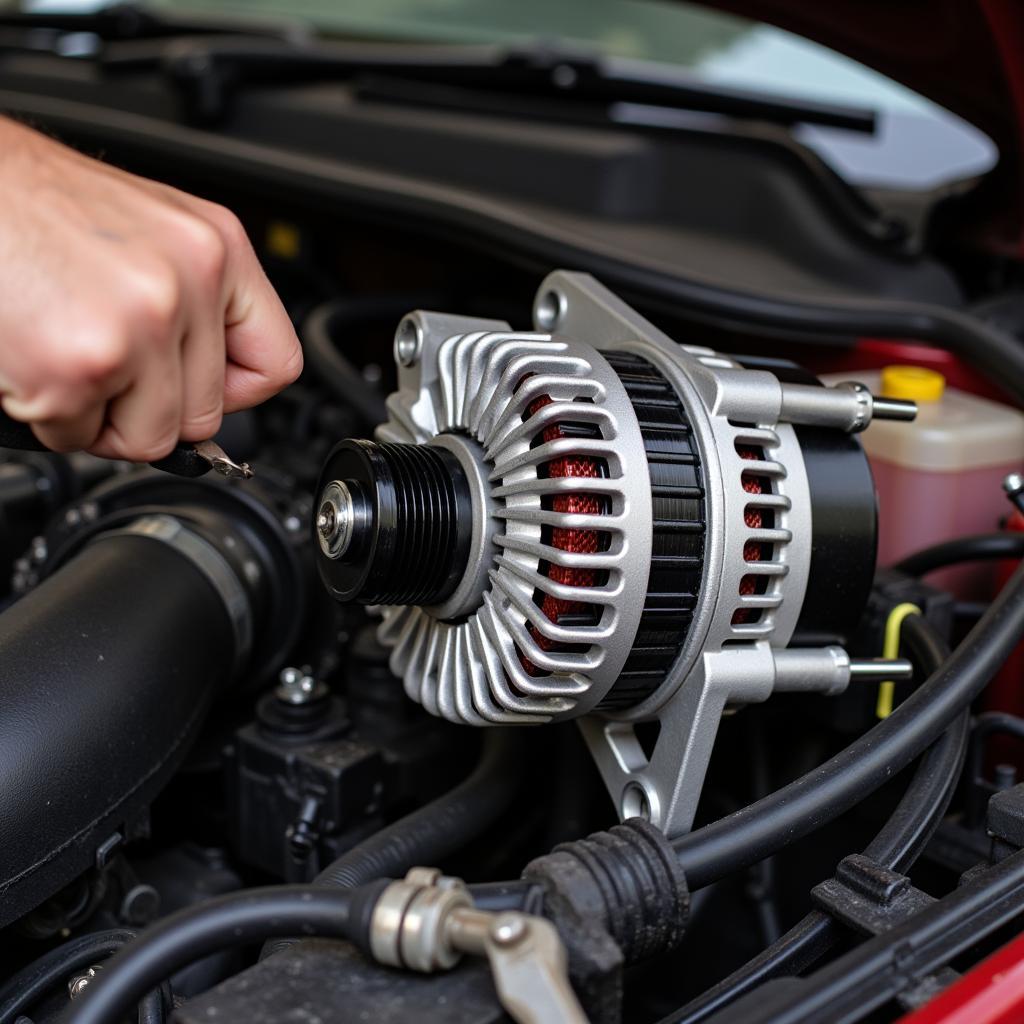A brake warning light illuminating on your dashboard while driving can be a nerve-wracking experience. This light, often accompanied by an exclamation mark or the word “BRAKE,” signals a potential issue with your vehicle’s braking system. While it can be tempting to ignore a seemingly minor warning, addressing the underlying cause promptly is crucial for your safety and the longevity of your vehicle.
Understanding Your Brake Warning Light
Your car’s brake warning light serves as an early alert system, designed to grab your attention if it detects a problem within the braking system. This light can be triggered by various issues, some more serious than others.
Common Causes of a Brake Warning Light
Let’s delve into some of the most prevalent reasons why your brake warning light might activate while driving:
1. Low Brake Fluid Level
One of the most common culprits is low brake fluid, often caused by worn brake pads or a leak in the braking system. Brake fluid is essential for transmitting the force you apply to the brake pedal to the wheels, enabling your vehicle to stop. When the fluid level drops too low, the warning light is triggered.
2. Worn Brake Pads
Brake pads are designed to wear down over time. As you apply the brakes, friction between the pads and rotors slows the vehicle. When the pads become too thin, a sensor embedded within them (or a mechanical indicator) triggers the brake warning light, signaling the need for replacement.
3. Faulty Brake Light Switch
The brake light switch, located near the brake pedal, is responsible for activating your brake lights when you press the pedal. A malfunctioning switch can disrupt the signal, leading to the brake warning light appearing on your dashboard.
4. ABS Issues
Modern vehicles are equipped with Anti-lock Braking Systems (ABS) to prevent wheel lockup during hard braking. A problem with the ABS module, sensors, or wiring can illuminate the brake warning light. In some cases, the ABS warning light might also illuminate alongside the brake warning light.
5. Parking Brake Engaged
It might seem obvious, but accidentally leaving the parking brake partially engaged is a surprisingly common reason for the brake warning light to come on. Always double-check your parking brake before driving.
What to Do When Your Brake Warning Light Comes On
If your brake warning light comes on while driving, don’t panic. Instead, follow these steps:
-
Safely pull over. Find a safe location to park your car away from traffic.
-
Check your parking brake. Ensure the parking brake is fully released.
-
Inspect brake fluid level. If you feel comfortable and know how to do so safely, check the brake fluid level in the reservoir. If it’s low, adding more fluid might temporarily resolve the issue, but it’s crucial to have your braking system inspected by a professional as soon as possible.
-
Avoid driving further if possible. If the brake fluid is extremely low, you notice a leak, or experience any changes in brake pedal feel (spongy, soft, or going to the floor), do not continue driving. Instead, call a tow truck to transport your vehicle to a trusted mechanic.
Diagnosing and Resolving Brake Warning Light Issues
While some causes of a brake warning light, like a disengaged parking brake or low brake fluid, might be straightforward to address, others require professional diagnosis and repair. Here are some diagnostic and repair approaches:
1. Visual Inspection:
A mechanic will begin by visually inspecting the brake system components, including brake lines, hoses, calipers, and rotors, for signs of leaks, damage, or wear.
2. Diagnostic Scanning:
For more complex issues, especially those related to ABS, a diagnostic scan tool can read trouble codes stored in the vehicle’s computer, pinpointing the source of the problem.
3. Component Testing:
The mechanic might test individual components like the brake light switch, ABS sensors, and the ABS module to ensure they function correctly.
Brake Warning Light FAQs
Q: Can I drive with my brake warning light on?
A: It’s not recommended. While you might be able to drive a short distance, any issue affecting your braking system poses a serious safety risk.
Q: How much does it cost to fix a brake warning light issue?
A: The cost can vary greatly depending on the underlying cause. A simple brake fluid top-up might cost very little, while replacing major components like the ABS module can be significantly more expensive.
Q: How often should I check my brake fluid?
A: It’s good practice to check your brake fluid level at least once a month and more frequently if you notice any changes in brake pedal feel.
Q: Can I add any brake fluid to my car?
A: No. Always use the type of brake fluid specified in your vehicle’s owner’s manual. Using the wrong type can damage your braking system.
Take Action for Your Safety
A brake warning light should never be ignored. Addressing the issue promptly ensures your safety and prevents potentially costly repairs down the line. Remember, maintaining a well-maintained braking system is paramount for a safe and enjoyable driving experience.
If you’re experiencing issues with your brake warning light, consider seeking professional automotive services, such as those offered by specialized technicians who can perform remote diagnostics, programming, and software installations to address various car problems. For more information on specific brake warning light issues, you can check out our articles on why does my brake warning light stay on while driving, Chrysler Sebring 2010 brake warning light coming on while driving, brake light 2016 Subaru warning lights meaning, parking brake warning switch, and BMW 328i brake pad warning light.


